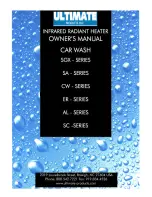
5
CLEANING
The glass in the fire door has special heat resisting qualities
and will adequately withstand the operating temperatures
reached by the appliance. However, it must be remembered
that glass is fragile and care must be taken to avoid rough
treatment, which could lead to breakage. Cleaning should be
carried out regularly to avoid discolouration. DO NOT CLEAN
WHILST HOT. Open door and allow glass to cool before
wiping with a damp cloth.
Note: Should replacement glass be required, this can be
obtained from your local Builders’ Merchant.
Painted Parts
When the appliance is cool, wipe the surfaces with a damp
cloth. DO NOT ATTEMPT TO CLEAN WHILST APPLIANCE
IS HOT, NOR USE ABRASIVE CLEANERS. Finally polish
with a soft cloth.
Flue Cleaning
It is necessary to hinge down the throat plate monthly so as to
clear any flue deposits from the plate and flue outlet. To
achieve this, locate the operating tool in the cutout at the front
of the throat plate. Lifting slightly and pulling forward the
throat plate will be released and can be lowered into its
cleaning position (See Fig. 2). Scrape or brush all deposits
from the throat plate and flue outlet. Replace throat plate
ensuring it is correctly located.
Chimney Sweeping
Where the chimney is believed to have served an open fire
installation it is possible that the higher flue gas temperatures
from a room heater may loosen deposits that were previously
firmly adhered, with consequent risk of flue blockage. It is
therefore recommended that the chimney be swept a second
time shortly after the room heater has commenced operation.
The chimney should be swept annually to ensure that a
complete evacuation of flue gases is always possible. This
can be carried out through the fire opening after having
removed the throat plate. Remember to remove any deposits
from the top of the boiler before replacing throat plate.
Flexible chimney sweeping rods should be used to facilitate
cleaning.
Grate Removal
This appliance is fitted with a reciprocating shaker grate
having ten individual bars fitted alternately on two rods, five
bars with short-necked hooks on the lower rod and five bars
with long necked hooks on the upper rod.
To remove, lift out deepening bar and fire front plate, bring the
bottom rod in the forward position, lift each bar upwards, push
to the rear until clear of the rod and withdraw. When all
bottom bars have been removed, bring the upper rod forward
and repeat as for the lower bars. Refit bars in the reverse
order.
Note: Ensure that the bars are placed alternately and that the
short-necked bars are on the lower rod and the long necked
ones on the upper rod. The rear of the bars is supported on a
bracket at the back of the boiler.
Replace the fire front plate, the base must rest in the ‘U’
brackets to keep it clear of the fire bars (See Fig. 3). The
deepening bar can now be fitted above it in the retaining
guides.
Shaker Rod Removal
Remove the two fixing screws holding the small plate on the
right-hand side of the boiler and withdraw shaker rod.
CO Alarm
Your installer should have fitted a CO alarm in the same
room as the appliance. If the alarm sounds unexpectedly,
follow the instructions given under the section above
“WARNING NOTE.”
Maintenance
SHUTTING DOWN
When letting the fire out for the summer months or for any
other prolonged period the following procedure should be
carried out:
1. Remove all fuel from firebox and empty ash can.
2. Remove throat plate and front fire bars and thoroughly
scrape all internal surfaces of firebox.
3. To guard against corrosion it is recommended that all
surfaces of firebox are sprayed or brushed with an anti-
corrosion treatment.
4. As a further safeguard against corrosion leave the fire door
partially open to ensure good ventilation of the appliance.
Fig 2
Fig 3
Summary of Contents for BURRINGTON
Page 12: ...12 THE BURRINGTON ROOMHEATER...































